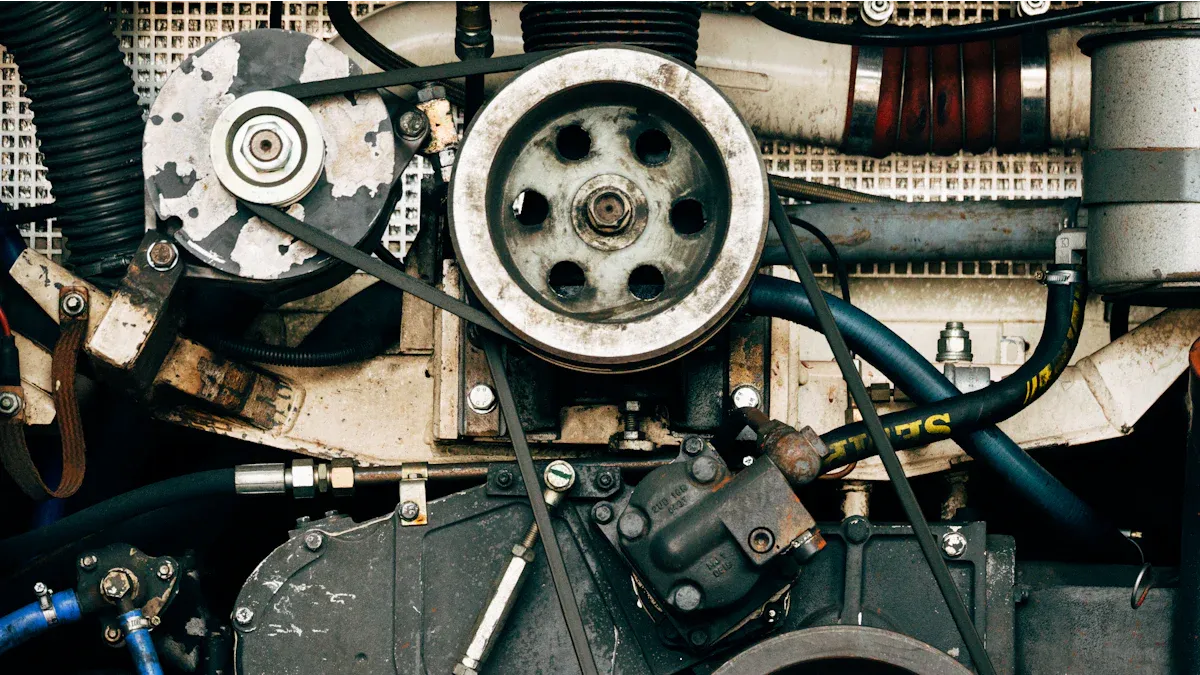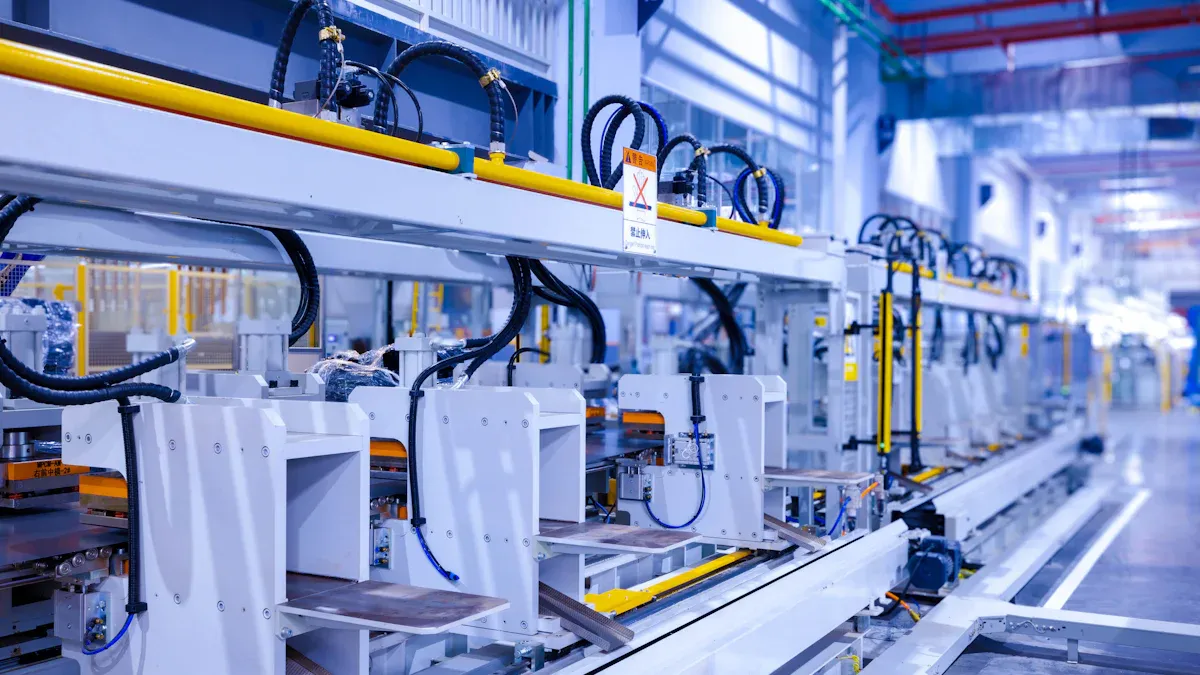
Selecting the right wear parts manufacturer is critical for the success of your operations. Reliable manufacturers ensure your equipment lasts longer and performs efficiently. This is especially important as industries expand and adopt advanced technologies. For instance, the construction sector’s growing investment in infrastructure, such as the $18 billion spent in 2023 in the UK, highlights the need for durable wear parts to minimize downtime and costs.
When choosing a manufacturer, focus on quality, production capabilities, and reputation. Customization and dependable customer support also play vital roles in meeting your specific needs.

The lifespan of your equipment depends heavily on the quality of its components. A reliable wear parts manufacturer ensures that your machinery operates efficiently for longer periods. Using OEM replacement parts, for example, guarantees superior quality and durability. These parts are specifically designed for your equipment, reducing wear and tear. Scheduled servicing and predictive maintenance technologies also play a crucial role. They allow you to monitor equipment health in real time, ensuring timely replacements and minimizing unexpected breakdowns. By choosing a manufacturer that prioritizes advanced technologies and design enhancements, you can significantly extend the operational life of your machinery.
Investing in high-quality wear parts may seem expensive initially, but it saves you money in the long run. Advanced wear parts manufacturers often incorporate innovative materials and designs that reduce friction and energy consumption.
A case study revealed that predictive maintenance reduces direct maintenance costs by lowering the frequency of repairs and the need for spare parts. Additionally, approximately 23% of global energy consumption is linked to tribological contacts, highlighting the economic benefits of reducing wear and friction.
By partnering with a manufacturer that offers durable and efficient parts, you can cut down on energy costs, storage expenses, and downtime, ultimately improving your bottom line.
Choosing the right wear parts manufacturer provides more than just operational benefits. It positions your business for long-term success. High-quality parts improve equipment performance, ensuring smoother operations and a safer work environment. Reliable suppliers also help you build trust with clients by delivering consistent results.
- Sourcing premium replacement parts leads to significant cost savings over time.
- Preventive maintenance training for employees reduces the risk of equipment failure.
- A computerized maintenance management system (CMMS) streamlines operations, making audits and regular maintenance more
efficient.
Additionally, manufacturers that invest in research and development (R&D) offer innovative solutions that give you a competitive edge. For instance, advanced composite materials from leading companies last up to five times longer than traditional parts, reducing operational costs significantly. Long-term partnerships with such manufacturers ensure consistent quality and supply, helping you stay ahead in your industry.

When selecting a wear parts manufacturer, you should prioritize those with recognized certifications. These certifications ensure that the manufacturer adheres to strict quality standards, which directly impact the performance and durability of the parts. For example, ISO 9001 certification guarantees that the manufacturer follows a robust quality management system, ensuring traceability and consistency in their products.
Different industries require specific certifications. The table below highlights some key standards:
| Standard | Industry/Application | Description |
|---|---|---|
| ISO 9001 | General | Quality management standard requiring traceability for products and parts. |
| AS9100 | Aerospace and Defense | Establishes requirements for part identification and traceability. |
| IATF 16949 | Automotive | Sets marking and traceability requirements for automotive parts. |
| FDA UDI | Medical Devices | Specifies marking requirements for medical devices to ensure safety. |
| IPC-A-610m | Electronics/Semiconductors | Provides marking guidelines for electronics components. |
| API | Oil and Gas | Outlines marking specifications for components in the oil and gas industry. |
These certifications not only validate the quality of the parts but also ensure compliance with industry-specific regulations. Manufacturers with these credentials demonstrate their commitment to delivering reliable and high-performing products.
Additionally, you should look for manufacturers that provide detailed documentation, such as material identification, chemical composition, and test results. This information ensures that the parts meet your specific requirements and perform as expected in demanding conditions.
A wear parts manufacturer with advanced manufacturing capabilities can significantly enhance the performance and lifespan of your equipment. Modern techniques, such as additive manufacturing, precision machining, and advanced coatings, allow manufacturers to produce parts that are lighter, stronger, and more wear-resistant.
Here are some key advantages of advanced production techniques:
- Additive manufacturing ensures consistent quality across varying batch sizes, unlike traditional methods that rely on economies of scale.
- Advanced coatings and surface treatments improve resistance to friction, heat, and wear, extending the lifespan of the parts.
- Evolving material technologies, such as composite formulations, provide superior strength and durability compared to traditional materials.
For instance, a case study on gear production using ultra-high-performance engineering plastics (UPE) demonstrated how transitioning to advanced materials and CNC operations increased the lifespan of gears and improved customer satisfaction. Similarly, automated UPE machining reduced production time and waste while maintaining consistent quality.
By choosing a manufacturer that invests in research and development, you gain access to innovative solutions that keep your equipment running efficiently. Manufacturers that collaborate with research institutions and technology partners often lead the way in developing cutting-edge technologies, giving you a competitive edge in your industry.
Experience and reputation play a crucial role in determining the reliability of a wear parts manufacturer. A manufacturer with years of experience in your industry understands the unique challenges and requirements of your operations. They can provide tailored solutions that meet your specific needs.
Reputation, on the other hand, reflects the trust and satisfaction of previous clients. You can evaluate a manufacturer's reputation by researching reviews, testimonials, and case studies. Look for manufacturers that consistently deliver high-quality products and exceptional customer service.
Experienced manufacturers often have a proven track record of success. They understand the importance of using high-grade materials, precision manufacturing processes, and rigorous quality control measures. For example, manufacturers that specialize in oil and gas applications often use API-certified components to ensure safety and reliability in harsh environments.
Partnering with a reputable manufacturer not only ensures the quality of your wear parts but also provides peace of mind. You can trust that they will deliver on their promises and support your business in achieving long-term success.
Customization plays a vital role in ensuring that wear parts meet the specific demands of your equipment and industry. A wear parts manufacturer offering tailored solutions can help you optimize performance, reduce downtime, and address unique operational challenges. Off-the-shelf components may not always fit your requirements, but custom-designed parts ensure compatibility and efficiency.
Manufacturers specializing in customization often use advanced techniques like precision forging, CNC machining, and material engineering to create parts that align with your specifications. For example, in the automotive industry, custom-forged components have been used to enh ance vehicle performance while reducing weight. This approach not only improves fuel efficiency but also minimizes defects. Similarly, in aerospace, manufacturers have developed turbine blades with a superior strength-to-weight ratio, meeting tight deadlines and improving operational efficiency.
Here are additional examples of how tailored solutions have benefited various industries:
- Smooth Curved Chutes: A cereal manufacturer reduced particle damage and increased processing yields by customizing transport chutes with ultra-high molecular weight (UHMW) sheets.
- Watertight Hatch Covers: A marine research company designed custom hatch lids to prevent seawater ingress, ensuring the reliability of underwater drones.
Customization also allows you to address specific challenges, such as high-impact stresses or extreme environmental conditions. For instance, a heavy machinery manufacturer created custom-forged parts to withstand high-impact stresses, resulting in reduced downtime and longer equipment lifespan. By partnering with a manufacturer that prioritizes specialized solutions, you gain the flexibility to adapt to changing operational needs and maintain a competitive edge.
Tip: When evaluating a manufacturer, ask about their ability to provide custom designs and whether they collaborate with you during the design process. This ensures the final product aligns with your exact requirements.
Pricing is a critical factor when selecting a wear parts manufacturer, but it should never come at the expense of quality. A cost-effective solution balances affordability with durability and performance. High-quality wear parts may have a higher upfront cost, but they save you money in the long run by reducing maintenance expenses and extending equipment life.
To assess value for money, you need to conduct a thorough cost-benefit analysis. This involves evaluating the total cost of ownership, including initial purchase price, maintenance, and replacement costs. Accurate cost calculations help you eliminate unnecessary expenses and optimize resource allocation. The table below highlights key insights into cost management:
| Key Insight | Benefit |
|---|---|
| Collecting and calculating cost data optimizes cost management. | Helps identify areas for cost reduction. |
| Assessing manufacturing costs determines product profitability. | Ensures pricing aligns with profitability goals. |
| Cost control boosts profitability in manufacturing industries. | Improves overall financial performance. |
| Accurate cost calculation eliminates irrelevant costs. | Optimizes resource allocation. |
| Comparing costs of different processes identifies the most efficient method. | Reduces production expenses. |
| Negotiating with suppliers reduces raw material costs. | Lowers overall manufacturing costs. |
Understanding these factors allows you to make informed decisions about outsourcing versus in-house production. For example, comparing the costs of different manufacturing processes can help you identify the most efficient method for producing wear parts. Additionally, negotiating with suppliers can reduce raw material costs, further enhancing profitability.
Note: Always consider the long-term benefits of investing in high-quality wear parts. While cheaper alternatives may seem appealing, they often lead to higher maintenance costs and frequent replacements, which can erode your bottom line.
By choosing a manufacturer that offers durable and efficient parts at a fair price, you ensure that your investment delivers maximum value. This approach not only reduces operational costs but also enhances the overall performance and reliability of your equipment.
Reviews and testimonials provide valuable insights into the reliability and performance of a wear parts manufacturer. By examining feedback from other businesses, you can gauge the manufacturer’s ability to meet deadlines, deliver quality products, and prov ide excellent service.
Here’s a table showcasing real-world testimonials from various industries:
| User | Testimonial |
|---|---|
| Construction Service Company | "Pacific Alloy has been producing castings for us since 2004. I find their production schedules reliable. Pacific Alloy has always responded in a timely manner to our needs regarding production design, changes, and quality." |
| Concrete Pumps & Shotcrete Equipment Manufacturer | "We have been buying castings, wear rings, wear plates, and more with Pacific Alloy for many years. They have been very easy to work with and deliver quality parts on time. We are happy with the service overall and will recommend to others in the industry." |
| International Mining, Aggregates, Oil & Gas and Flow Control | "Pacific Alloy is one of our top casting suppliers with excellent quality and on-time delivery with our High-Chrome Iron and Ni-Hard materials. They also communicate very well and provide us with solutions not problems." |
| Agricultural Wear Parts Purchaser | "Ever since I found Pacific Alloy Casting, my cost of production has gone down. I am extremely happy with the work that I receive, and the turn-around time combined with the great customer service, makes working with them a pleasurable experience." |
When researching reviews, focus on patterns in customer feedback. Consistent praise for quality, timeliness, and communication indicates a dependable manufacturer. Negative reviews, especially those highlighting recurring issues, should raise red flags.
Tip: Look for testimonials from businesses in your industry. Their experiences will be more relevant to your specific needs.
Requesting product samples is a practical way to evaluate a manufacturer’s capabilities. Samples allow you to assess the quality, fit, and functionality of the parts before committing to a larger order. This step minimizes risks and ensures the manufacturer can meet your expectations.
Here’s a step-by-step guide to evaluating product samples:
1. Measurement: Verify that the sample matches the required dimensions and specifications.
2. Construction: Inspect the build quality, including welds, joints, or other critical features.
3. Materials & Finishing: Examine the material’s durability and the finishing details for signs of wear resistance.
4. Fit & Functionality: Test the sample in your equipment to ensure compatibility and performance.
5. Feedback: Communicate any necessary adjustments to the manufacturer for refinement.
By following these steps, you can make informed decisions about the manufacturer’s ability to deliver parts that meet your operational needs. Samples also provide an opportunity to test the manufacturer’s responsiveness and willingness to accommodate your feedback.
Note: Always request samples made from the same materials and processes as the final product. This ensures the sample accurately represents the quality you can expect.
Customer support plays a crucial role in your relationship with a wear parts manufacturer. A responsive and proactive support team ensures smooth communication, timely issue resolution, and a better overall experience.
Manufacturers that prioritize customer service often integrate digital technologies to enhance responsiveness. For example, automated systems can provide real-time updates on order status, while dedicated support teams address inquiries promptly. These practices align service speed with customer expectations, improving satisfaction and trust.
Long-term relationships with manufacturers depend on effective communication and customized solutions. A manufacturer that listens to your concerns and adapts to your needs demonstrates a commitment to your success. This level of support not only enhances your experience but also ensures a reliable supply chain for your operations.
Tip: Test the manufacturer’s responsiveness by reaching out with questions or concerns during the evaluation process. Their response time and quality of communication will give you a clear picture of their customer service standards.
Focusing solely on low pricing often leads to poor decisions. While saving money is important, prioritizing cost over quality can result in frequent part failures and higher operational expenses. Cheap wear parts may lack durability, causing equipment to break down more often. This increases downtime and repair costs.
Disregarding technical specifications is another common issue. Parts that do not fit properly or fail to meet performance standards can compromise your equipment's efficiency. For example, inadequate testing of wear parts often results in selecting components that underperform or fail prematurely. Always balance cost considerations with quality and performance to avoid long-term losses.
Tip: Conduct a cost-benefit analysis to evaluate the total cost of ownership, including maintenance and replacement expenses.
After-sales support is a critical factor that many overlook. Manufacturers that provide robust support ensure smooth operations and quick problem resolution. Without reliable support, you may face delays in receiving replacements or technical assistance. This can disrupt your workflow and increase downtime.
Maintenance and replacement needs should also be part of your evaluation. A manufacturer that offers comprehensive after-sales services, such as maintenance training or spare part availability, adds significant value. Neglecting this aspect can lead to unexpected breakdowns and higher costs.
Note: Test the manufacturer’s responsiveness by reaching out with inquiries during the evaluation process. Their response time reflects their commitment to customer service.
Ignoring certifications and compliance standards can jeopardize your operations. Certified manufacturers adhere to strict quality management systems, ensuring consistent and reliable products. For instance, companies like Frigate, certified under ISO 9001:2015, demonstrate their commitment to quality.
Compliance records also highlight the importance of rigorous quality control. Manufacturers with NADCAP accreditation for welding and heat treatment ensure their processes meet industry-specific requirements. Similarly, FAA-compliant manufacturers use calibrated tools and conduct thorough inspections to guarantee safety and reliability.
Tip: Always verify a manufacturer’s certifications and audit trails. This ensures their products meet your industry’s regulatory standards and performance expectations.
Choosing the right wear parts manufacturer is more than just a business decision—it’s an investment in your equipment’s performance and your company’s future. Prioritizing quality and reliability ensures your operations run smoothly and efficiently. Long-term value comes from durable parts that reduce downtime and maintenance costs.
Tip: Always evaluate manufacturers thoroughly. Look beyond pricing and focus on certifications, customer support, and customization options.
The right manufacturer doesn’t just supply parts; they become a trusted partner in your success. By making informed decisions, you position your business for growth and operational excellence.
Look for certifications like ISO 9001 for quality management, API for oil and gas, and AS9100 for aerospace. These ensure the manufacturer meets industry standards and delivers reliable products.
Request product samples. Check dimensions, material durability, and compatibility with your equipment. Testing the sample in real-world conditions ensures it meets your operational needs.
Custom solutions optimize performance and reduce downtime. Off-the-shelf parts may not fit your equipment perfectly. Tailored designs ensure compatibility and address unique challenges in your operations.
Focus on long-term value. High-quality parts reduce maintenance costs and extend equipment life. Conduct a cost-benefit analysis to evaluate total ownership costs, including replacements and downtime.
Test their responsiveness by asking questions during the evaluation process. Look for real-time updates, proactive communication, and willingness to address concerns. Reliable support ensures smooth operations.